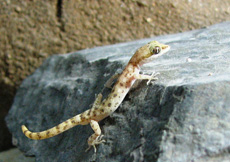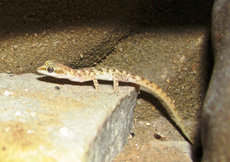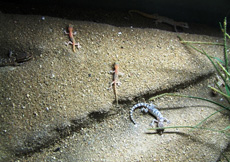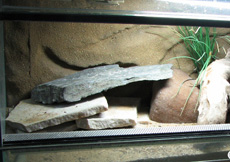Tropiocolotes steudneri
(PETERS, 1869)
Distribution:
Tropiocolotes steudneri is found in North Africa from Algeria to the Red Sea and southwards to Sudan.
Description:
The geckos reach a total length of about 7 centimeters, their body accounts for more than half of their size. Males usually remain smaller than females and are clearly able to be distinguished by their Hemipenis pockets. The basic color is sandy brown with dark and light spots, the tail is marked with brown bands. A dark band extends from the tip of the snout through the eye to about their shoulder.
Habitat:
Tropiocolotes steudneri colonizes dry areas of desert boulders. They live between and among larger stones, but are also synanthropic and can be found in hotels, etc. Pure sandy areas, exposed boulders without structures and shade are avoided.
Husbandry and Breeding:
Due to the very low levels of intra-aggressiveness it is quite possible to keep Tropiocolotes steudneri in groups. A terrarium measuring 60x30x30 centimeters would be fine for a group of six animals (three pairs). The enclosure should mimic their natural habitat with layers of flat stones and small pieces of wood that resemble the root system of trees. The substrate should be sand, a corner of the sand, preferably under the stones, should always be kept moist. Small clay pots can be slightly submerged in to the sand to offer additional places to retreat to. Illumination is provided by a fluorescent lamp. The animals should also be offered a location in the enclosure to bask, the basking site should reach a temperature of 35°C (95°F), which can easily be achieved using a small heat lamp. During the summer months, the temperatures should range between 26-30°C (79-86°F) daily and between 21-22°C (70-72°F) nightly.
The geckos are fed with small crickets and Drosophila, which should always be dusted with a vitamin-mineral mixture. During feeding Tropiocolotes steudneri exhibits a similar behavior to leopard geckos (Eublepharis macularius), where as prey will be stalked slowly with vigorous tail wagging. Similar behavior is reflected in the encounter between two males or between males and females; the animals form a posture similar to that of an arched cat's back, the enemy will also be meet with severe horizontal tail wagging, followed by occasional attacks. If food is readily within range it will be consumed without much show.
The animals should be allowed a two month period to hibernate at temperatures between 20-21°C (68-70°F) daily and about 17°C (63°F) nightly, after which the breeding season may resume. At the beginning of the season chirping sounds will be heard. These sounds can either be the geckos locating partners or territorial marking.
Four weeks after mating the females lay a hard-shelled single egg in loose sand or under stones, the egg can be seen well after three weeks through the abdomen of the female. About 3-5 eggs will be deposited per female during the breeding season. The eggs can either be left in the terrarium or incubated in a small box on dry sand.
Depending on incubation temperatures, the young animals usually emerge after 58 to 80 days and have a total length of about 2 centimeters. They can be reared separately in small terrariums or in with the parents.
Tropiocolotes steudneri makes for a very impressive terrarium occupant with its fascinating and active behavior. The animals are very hardy, so they can be recommended for even the very beginner.




